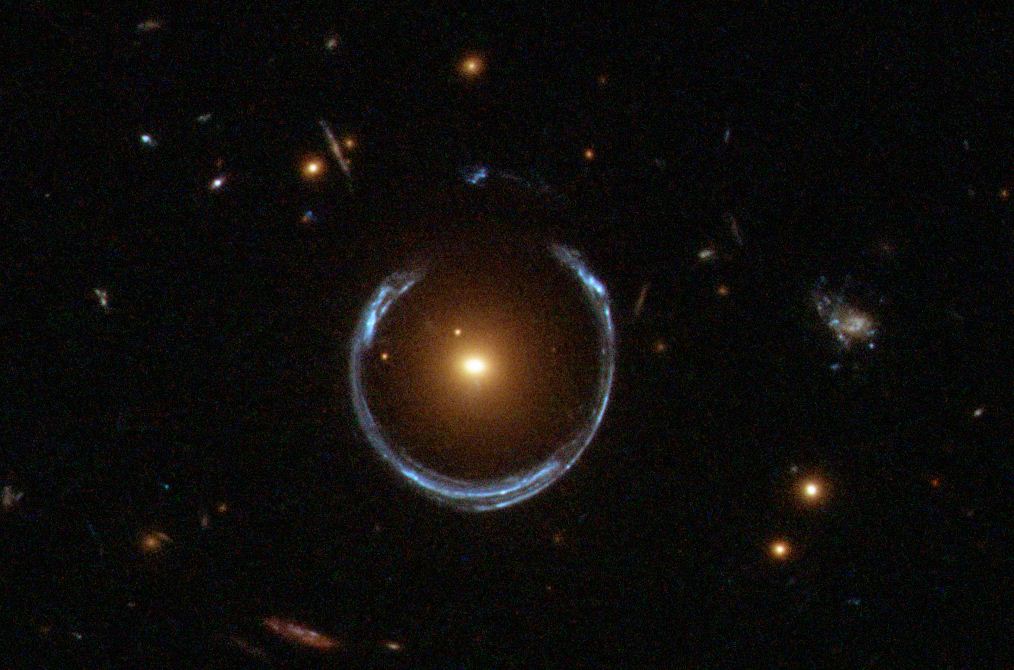Physicist: The very short answer is: nope. Well… almost certainly nope.
“Dark matter” is stuff that we can’t see or touch, but we know it exists because it affects the motion of regular matter, which we can see. Although there were vague hints that dark matter might be a thing going back about a century, it wasn’t until the 1970s that direct observations of the movements of stars in galaxies revealed the presence of too much matter. Way too much.
There’s so much more dark than regular matter in the universe, that its gravitational influence more or less dictates where the biggest concentrations of matter (galaxies and even galaxy clusters) end up.

By including dark matter in mathematical simulations, we get results that correspond well with the largest-scale distribution of matter in the universe, as well as the development of galaxies we see today.
One (possible) prediction of string theory is that our universe is a “brane“, a “sheet” of spacetime floating about in a higher dimensional space called the “bulk”. Other branes (other universes) might be floating around nearby, almost overlapping our universe, some small distance away. All of the particles native to a brane are stuck to it, but the gravity they produce might not be. So perhaps what we perceive as dark matter is really just the gravitation from matter in another nearby universe. That would explain why we don’t see it and why it doesn’t bump into things.

Artist’s interpretation of Brane Cosmology. Particles are stuck to branes (the sheets), which exist in a higher dimensional “bulk” spacetime (the back yard), but gravity from one brane can affect things in another. Maybe.
The danger of this line of thinking is that it requires taking several steps beyond the shelter of direct experimental evidence. The bulk, other branes, and even string theory itself are just a bunch of interesting ideas, since none of the theory’s novel predictions have been supported by experiment (so far).
Before delving into brane stuff, it’s worth considering what we know about dark matter. By carefully tallying up the number of stars, the distribution of their masses, the amount of gas and dust (by looking at how the local starlight filters through it), and then figuring out the amount of gravity due to all of it, we can figure out how fast each star in a galaxy should be orbiting said galaxy. We found two things: first, that there’s many times more matter in play than we can see and second, that this unseen matter is distributed around every large galaxy as though it had never been subject to accretion. That last bit is important.

Chunks of ordinary matter (orange) can bump into each other, causing them to slow down and concentrate in one place. Dark matter (grey) doesn’t bumping into anything, including itself, so it stays spread out.
Accretion is why stuff in space tends to clump together or flatten out into disks (or both!). When stuff has the option of bumping into itself, collections of matter go from incomprehensibly big, fluffy clouds, to concentrated pin-points (like stars and planets).

The four light-year tall Pillars of Creation form a tiny corner of the Eagle Nebula. This gas and dust is extremely spread out, but through accretion it concentrates a lot. If those pillars were each the size of Florida, the stars forming inside of them would be roughly the size of a piece of fruit.
By looking at the orbital speeds of stars vs. the distance to their galaxy’s cores we find that they are orbiting a disk of stuff as well as a diffuse cloud with around ten times the mass (the exact ratio varies from galaxy to galaxy). So whatever dark matter is, there’s lots of it and it doesn’t bump into anything.
The big difference between the 1970s and now is computer power, space telescopes, and the gradual muting of hairstyles. And nothing else. As our telescopes and computers improved slightly over the last few decades, we’ve been able to determine not just that dark matter exists, but where it exists and how much is around. Gravitational lensing bends light as it passes really heavy things. Determining the amount of mass in something based on how much it distorts the image of things behind it is something that’s very difficult to do with a slide ruler, but is pretty easy with a post-Pong-era computer.

A remarkable alignment of us (the camera), a galaxy (orange blurry thing), and a distant galaxy (smeared out blue ring). The gravity of the orange galaxy warps the image of the galaxy behind it.
If dark matter and regular matter show up in more or less the same place (which they usually do), then it’s difficult to tell the difference between the existence of dark matter and a misunderstanding of how gravity works. Luckily, dark matter is not only heavy but weakly interacting; a property that reveals itself when huge blobs of ordinary matter collide and their associated blobs of dark matter notably don’t.
The Bullet Cluster is actually a pair of colliding galaxy clusters. When galaxies or galaxy clusters collide their stars miss each other (because stars are stupid small compared to the distances between them), but their massive gas clouds find each other just fine. When they do, they heat up (not just from the physical impact but from being tossed around by their mutual magnetic fields) until they glow in the x-ray spectrum. Shining with x-rays makes these impacts stand out pretty clearly. So you’d expect that when galaxy clusters run into each other there should be a decent smearing of mass with a big chunk in the middle where the gas clouds pancake into each other. Instead, we see some hot gasses in the middle of the impact with the vast majority of the mass taking the form of two big chunks that cruised right through.

The Bullet Cluster is a collection of galaxies 3.7 billion light-years away (behind all the other galaxies and stars seen here). In this (very altered) picture the foreground galaxies are imaged in the visible spectrum (that’s actually what they look like), the pink blur is x-rays emitted by the colliding clouds of gas in the two clusters, and the purple is an overlayed map of matter density generated by analyzing gravitational lensing.
The point here is that dark matter is literal, actual stuff, not just a massively boneheaded mistake or miscalculation. You can point at where it is, say how much is there, and even talk about what it’s doing. We just can’t directly detect it because it doesn’t touch anything. As it turns out, that isn’t completely strange.
Different particles interact through different forces. For example, protons interact through all four fundamental forces: the strong nuclear force, the weak nuclear force, the electromagnetic force, and gravity. The strong force, keeps protons and neutrons packed tightly together in atomic nuclei. Electrons on the other hand interact through all but the strong force, which is why they buzz around the nucleus instead of being inside it.
Neutrinos only interact through the weak and gravitational forces. When you try and fail to walk through a wall, you’re interacting through the electromagnetic force. Without the electromagnetic force, neutrinos are free to pass right through damn near anything. On the order of a trillion pass through your body every second, and yet our best, biggest neutrino detectors only pick up a couple dozen a day (mostly from the Sun, and the detectors work both day and night since neutrinos don’t really notice the Earth). Since they interact through the weak force (and not very well) neutrinos are “weakly interacting”.
Whatever dark matter is, it seems to take things one step further: interacting through gravity alone. Without the strong force it wouldn’t form elements. Without the electromagnetic force it passes through ordinary matter and itself. And without the weak force we’re left with no way to directly detect it. But if there’s enough of it (and there seems to be), then we can detect its gravity.
Right now the search for dark matter is a little like setting out traps in your house because your cheese keeps going missing and you can hear skittering in the walls. There’s definitely something there and you know more or less where it is and what it’s like, but it would be nice to know exactly what you’re dealing with.
So to actually answer that question from way back when: could dark matter be the gravity of stuff in another universe (or brane or whatever) bleeding into ours? Probably not. Dark matter doesn’t interact with ordinary matter, which could be because it’s on a different brane. But even so, based on how it gets distributed we know that it doesn’t interact with itself either. So bringing extra universes into play doesn’t answer any questions, it just muddies up an existing question with untested ideas. It’s like using honey to get gum out of your hair; the situation is different, maybe even thought provoking, but not better.
The mathematical model of the universe picture is from here.
The “brane” picture is from here.
The space stuff is all from NASA.
The chewed up wire picture is from here.








Pingback: Dark Matter is Real. "Dark Matter" is a Terrible Name for It – Out There – Discover Magazine | Everyday News Update
Pingback: Dark Matter is Real. "Dark Matter" is a Terrible Name for It |